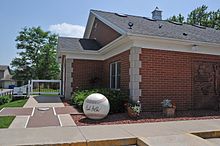Bob Feller
His career was interrupted by four years of military service (1942–1945) as a United States Navy Chief Petty Officer aboard USS Alabama during World War II.
[2]: 29 By the age of 16, Feller possessed what critics judged a high quality fastball; major league scouts traveled to Dayton, Ohio to watch him in the annual national baseball tournament.
He was planning to add Feller, along with outfielder Tommy Henrich, to the major league roster after a few exhibition and semi-pro games, without either playing for a farm club.
After a three-month investigation, concluding in December 1936, about whether the Indians broke any Major League Baseball rules by signing Feller, Commissioner Kenesaw Mountain Landis disagreed with the argument presented by Slapnicka and Indians president Alva Bradley, but awarded both Feller and Henrich free agency and required the club to pay a $7,500 fine, equivalent to $160,000 in 2023.
Indians manager Steve O'Neill had Denny Galehouse warmed up in the bullpen in case the 17-year-old Feller had early troubles, but he struck out all three batters he faced in the first inning, and recorded 15 strikeouts in earning his first career win.
[6][8] Three weeks later, he struck out 17 batters,[6][9] tying a single-game strikeout record previously set by Dizzy Dean, in a win over the Philadelphia Athletics.
[10] Feller's fame reached such a level that when he returned to Van Meter for his senior year of high school, the governor of Iowa greeted him.
[11] His record-setting rookie year made him, according to baseball writer Richard Goldstein, "the best-known young person in America, with the possible exception of Shirley Temple.
Perhaps in all the world only Sonja Henie had previously excelled at so young an age in any sport that mattered, and, after all, she was but a little girl wearing tights and fur trim, performing dainty figure eights.
– American demigods ... in the only professional team sport that mattered then in the United States.As the 1937 season began, Feller appeared on the cover of the April 19, 1937 issue of Time magazine.
There was drama in the air because of Greenberg's attempt to break Ruth's record, and the excitement grew even greater when my strikeouts started to add up", Feller said.
[22] Feller finished the 1939 season leading the AL in wins (24), complete games (24) and innings pitched (296+2⁄3), and led the majors for a second consecutive year in both walks (142) and strikeouts (246).
[27] Feller also led the majors with 31 complete games and 320+1⁄3 innings pitched, and won the Sporting News Player of the Year Award.
The test was conducted in Chicago's Lincoln Park, with Feller in street shoes, suit pants, dress shirt, and tie, pitching without a mound on an asphalt roadway.
[29] The still accelerating Harley-Davidson passed Feller going 86 mph (138 km/h), yet even with a generous head start the ball beat the bike to the target by several feet.
[10] That year, Joe DiMaggio talked about Feller's pitching ability, stating "I don't think anyone is ever going to throw a ball faster than he does.
Feller heard about the bombing while returning from a visit to his terminally ill father at Des Moines to Chicago where he was to sign a new Indians contract.
[35] Feller and the Alabama crew spent most of 1943 in the British Isles along with USS South Dakota, but in August were reassigned to the Pacific Theater of Operations.
Feller participated in the Battle of the Philippine Sea before his combat duty ended in January 1945; he spent the rest of the war at the Great Lakes Naval Training Station as an instructor.
[8] He was decorated with six campaign ribbons and eight battle stars while serving on missions in both the Pacific and North Atlantic, and was made an honorary member of the Green Berets later in life.
[44] Later research into box scores for Waddell's 1904 pitching appearances credited him with five additional strikeouts, moving the mark to 349 and bumping Feller from the top spot.
[49][50] In a June 13 game against the Philadelphia Athletics, having already amassed 10 strikeouts through four innings, Feller fell from the mound, which rain had made slippery, and injured his back.
In the eighth inning, Feller and Boudreau appeared to have picked off the Braves' Phil Masi as he attempted to steal a base, but umpire Bill Stewart ruled he was safe.
[59] In December 1956, Feller told The Plain Dealer: "I will return to Cleveland later this week and plan to confer with Hank Greenberg before Christmas.
His exhibition tours often featured other big leaguers and Negro league players, like Satchel Paige, who was also a teammate of Feller's with the Indians.
His first wife developed anemia after giving birth to their second child when she was given the wrong type of blood during transfusions; she subsequently became addicted to the prescribed medication for her condition.
[71] Feller's biographer John Sickels suggested: "They were trying to make money, but part of it was also, he felt that the black players weren't necessarily getting a fair chance and that he wanted to sort of showcase it.
Among them is footage of a Feller fastball being clocked by Army ordnance equipment (used to measure artillery shell velocity) and registering at 98.6 mph (158.7 km/h).
[84] Each year, American Legion Baseball presents the "Bob Feller Pitching Award" to the pitcher "with the most strikeouts in regional and national competition.
[95] By October, Feller was fitted with a pacemaker and was diagnosed with pneumonia and thrush, an infection of the mucous membrane lining the mouth and throat.






